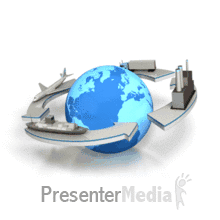Innovotek -News & BLOG
A blog about the news of the latest technology developments, breaking technology news, Innovotek Latest news and information tutorials on how to.
AddThis Sharing Buttons Reducing Supply Chain Costs With Better Transporation Logistics
- Font size: Larger Smaller
- Hits: 7601
- 0 Comments
- Subscribe to this entry
- Bookmark
 Establishing an environment of end-to-end supply chain visibility leads to more efficient manufacturing, lower costs and fewer incidents of a mismatch between supply and demand. In implementing that visibility, companies look at everything from sourcing raw materials, to manufacturing, to supplying the sales channel with finished product. However, a frequently missing component in a supply chain visibility strategy is transportation management, or the not-so-simple act of getting finished goods and raw materials from one location to the next.
Establishing an environment of end-to-end supply chain visibility leads to more efficient manufacturing, lower costs and fewer incidents of a mismatch between supply and demand. In implementing that visibility, companies look at everything from sourcing raw materials, to manufacturing, to supplying the sales channel with finished product. However, a frequently missing component in a supply chain visibility strategy is transportation management, or the not-so-simple act of getting finished goods and raw materials from one location to the next.
With increasingly tight margins and higher freight costs, even small supply chain oversights can cause unnecessary expense, in terms of scenarios like product write-offs or write-downs that may occur as a result of an oversupplied sales channel, missed sales opportunities due to an undersupplied sales channel, or higher-than-necessary costs due to a failure to monitor raw materials prices across multiple sources. But beyond that, the biggest "hidden" cost of a poor supply chain is transportation — and the cost of getting goods from one place to another may well mean the difference between profit and loss. Management of freight costs, especially in a large enterprise, becomes extremely important, and the connection between visibility of freight as a component of the supply chain, and the transportation economies that can come as a result, quickly becomes apparent — and in a low margin business, transportation economies are a vital component of establishing profitability.
Visibility isn't just a buzzword
The primary goal of almost every enterprise is to have supply chain visibility, but often it's little more than a marketing term and a buzzword thrown around to impress stockholders. Especially in larger enterprises, many companies still have yet to figure out how to implement true supply chain visibility, because as a business process, it requires system integration between so many different components, many of which have different sets of master data. To get visibility that provides data down to the product level, master data must be present and harmonized across all systems, including warehouse management systems, multiple ERP’s, ordering systems, and transportation systems, which may not have item-level detail.
The supply chain, when made up of sources across multiple geographies, requires attention to the glue that holds it all together, and that is getting materials from one point to another quickly and at the lowest price. The hidden costs of supply chain management aren't in materials, it's in transportation. Without that transportation visibility in the supply chain, unnecessary time lags and delays, cost overruns and backlogs can occur. Production schedules may be thrown off resulting in idle labor and lost sales.
Supply chain management is also very often a study in balancing time versus cost, and this is true especially in the transportation component. There will always be more than one way to ship goods from Hong Kong to Chicago, and with a little foresight, manufacturers can balance the cost of shipping through different ports against relative shipping time, and plan ahead to ensure that those materials are arriving timely and at the lowest possible freight cost.
A living organism
An enterprise supply chain is a living organism that changes frequently. New suppliers challenge incumbents with better prices and service, costs of raw materials may change based on commodity price fluctuations, and foreign exchange rates may determine when to source materials from one country or another. Distribution points change and the sales channel grows with the addition of new partners in different geographical regions. In short, the supply chain is not static — and as distribution requirements change, so too must the transportation system change in response.
Getting transportation out of the bubble
Integration between predictive analytics, supply chain management and transportation management can help address many of these problems, particularly as the supply chain becomes more global in scale and transportation-dependent. Furthermore, recent technological advancements are promising a tighter integration between visibility and physical product movement. For example, the surge of connected devices — the Internet of Things (IoT) — promises to connect pallets, trailers, and containers to enterprise systems to provide this visibility. However, even this amazing advancement in technology requires proper implementation to be successful.
Even large companies often myopically approach supply chain visibility by implementing discrete systems like transportation and warehouse management within a bubble. From a supply chain systems standpoint, harmony between these systems will result in greater visibility, lower incidence of supply chain error and overall lower costs.
An efficient transportation management system (TMS) leads to better supply chain visibility. From a predictive analytics standpoint, transportation systems can feed into a predictive analytics engine, and help improve performance. Once inventory is loaded into the channel, there's not much that can be done from a transportation standpoint to minimize the impact of over-forecasting or misrepresenting demand, and so the predictive analytics component becomes even more important to plan for more efficient transportation.
Efficient transportation management is the first step in visibility
Establishing supply chain visibility has many moving parts, from predictive analytics, to sourcing raw materials and components, and management of the sales channel. But the beginning point is always going to be transportation. If an enterprise has an efficient and integrated transportation management system, visibility throughout the entire supply chain will follow.
